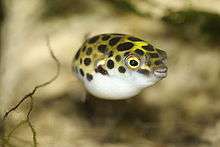Dichotomyctere nigroviridis
Dichotomyctere nigroviridis (syn. Tetraodon nigroviridis) is one of the pufferfish known as the green spotted puffer. It is found across South and Southeast Asia in coastal freshwater and brackish water habitats.[2] D. nigroviridis reaches a typical maximum length of about 15 cm (6 in) (5.9 in), with reports of up to 17 cm (6.7 in).[3] In February 2009, it was successfully bred in captivity at University of Florida using a new variation of the ovarian lavage technique.[4]
| Dichotomyctere nigroviridis | |
|---|---|
 | |
| Scientific classification | |
| Kingdom: | Animalia |
| Phylum: | Chordata |
| Class: | Actinopterygii |
| Order: | Tetraodontiformes |
| Family: | Tetraodontidae |
| Genus: | Dichotomyctere |
| Species: | D. nigroviridis |
| Binomial name | |
| Dichotomyctere nigroviridis (Marion de Procé, 1822) | |
| Synonyms | |
|
Tetraodon nigroviridis[1] | |
In the aquarium
Dichotomyctere nigroviridis is frequently raised in aquariums. However, the species' aggressive nature limits its ability to be housed with other fish. In captivity, specimens can grow up to 10 cm in length. The species is an omnivorous brackish water species and is most commonly raised in water with a pH level of 8. This species begins life in freshwater and progresses to saltwater throughout its life
Ecology
Adults of D. nigroviridis are found in freshwater streams, rivers, and flood plains; young are found in brackish water.[5] They are also found in mangrove forests.[2] Their diet consists primarily of snails, but includes mollusks, crustaceans, and some plant material.[5] This species may also be lepidophagous.[5] Its flesh contains a virulent toxin, and should not be eaten.
Genetics
D. nigroviridis has the smallest known vertebrate genome, roughly 340 million base pairs,[6] and has thus been selected as a model organism for genetics. In 2004, a draft of its genome sequence was published.[6]
Colour
D. nigroviridis is green on the body with black spots. Its belly is white and its fins and tail are light green.
Commercial importance
D. nigroviridis is by no means a food fish, but has some value as bait and is very widely traded as an aquarium fish,[5] and is sometimes mistaken as Dichotomyctere fluviatilis. D. nigroviridis also has some value as a lab animal, in particular in genetics, because it has the same number of genes as human beings, but in a genome about one-tenth the size.[7]
References
- Kottelat, M. (2013). The Fishes of the Inland Waters of Southeast Asia: A Catalogue and Core Bibliography of the Fishes Known to Occur in Freshwaters, Mangroves and Estuaries. The Raffles Bulletin of Zoology, 2013, Supplement No. 27: 1–663.
- Ebert, Klaus (2001-05-31). Aqualog: The Puffers of Fresh and Brackish Waters. Hollywood Import & Export, Inc. ISBN 3-931702-60-X.
- Schäfer F: Brackish Water Fishes, Aqualog 2005, ISBN 3-936027-82-X
- "Archived copy". Archived from the original on 2010-06-10. Retrieved 2011-04-12.CS1 maint: archived copy as title (link)
- Froese, Rainer and Pauly, Daniel, eds. (2017). "Dichotomyctere nigroviridis" in FishBase. February 2017 version.
- Jaillon O, Aury J, Brunet F, Petit J, Stange-Thomann N, Mauceli E, Bouneau L, Fischer C, Ozouf-Costaz C, Bernot A, Nicaud S, Jaffe D, Fisher S, Lutfalla G, Dossat C, Segurens B, Dasilva C, Salanoubat M, Levy M, Boudet N, Castellano S, Anthouard V, Jubin C, Castelli V, Katinka M, Vacherie B, Biémont C, Skalli Z, Cattolico L, Poulain J, De Berardinis V, Cruaud C, Duprat S, Brottier P, Coutanceau J, Gouzy J, Parra G, Lardier G, Chapple C, McKernan K, McEwan P, Bosak S, Kellis M, Volff J, Guigó R, Zody M, Mesirov J, Lindblad-Toh K, Birren B, Nusbaum C, Kahn D, Robinson-Rechavi M, Laudet V, Schachter V, Quétier F, Saurin W, Scarpelli C, Wincker P, Lander E, Weissenbach J, Roest Crollius H (2004). "Genome duplication in the teleost fish Tetraodon nigroviridis reveals the early vertebrate proto-karyotype". Nature. 431 (7011): 946–57. doi:10.1038/nature03025. PMID 15496914.
- "Pufferfish and ancestral genomes". Retrieved 2013-01-18.
External links
| Wikimedia Commons has media related to Tetraodon nigroviridis. |
- Genome database.
- View the tetraodon genome in Ensembl